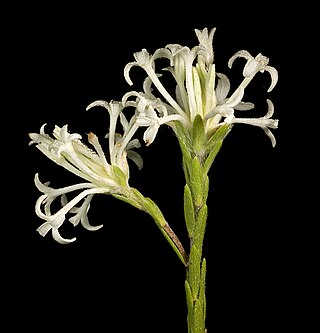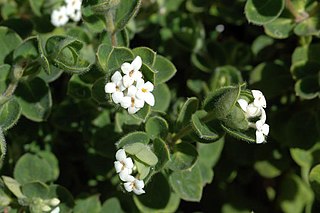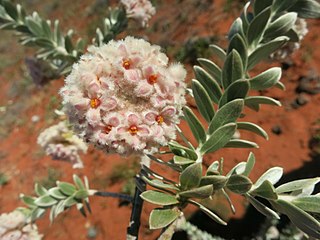
Pimelea ferruginea, commonly known as pink rice flower or coastal banjine, is a species of flowering plant in the family Thymelaeaceae and is endemic to near-coastal areas of south-western Western Australia. It is a dense, erect shrub with elliptic to narrowly elliptic leaves and head-like clusters of pale to deep pink, tube-shaped flowers.

Pimelea longiflora is a species of flowering plant in the family Thymelaeaceae and is endemic to the southwest of Western Australia. It is an erect, spindly shrub with linear to narrowly elliptic leaves and erect clusters of white to cream-coloured flowers, surrounded by 4 to 6 green, egg-shaped involucral bracts.

Pimelea altior is a species of flowering plant in the family Thymelaeaceae and is endemic to eastern Australia. It is a shrub with elliptic leaves and heads of white, tube-shaped flowers.

Pimelea amabilis is a species of flowering plant in the family Thymelaeaceae and is endemic to northern Queensland. It is a small shrub with narrowly elliptic or elliptic leaves and spikes of hairy, yellowy-green or yellow, tube-shaped flowers.
Pimelea approximans is a species of flowering plant in the family Thymelaeaceae and is endemic to northern Queensland. It is a perennial shrub with elliptic leaves and spikes of hairy, yellow, tube-shaped flowers.
Pimelea aquilonia is a species of flowering plant in the family Thymelaeaceae and is endemic to far north Queensland. It is a shrub with narrowly elliptic leaves and small clusters of hairy, white or cream-coloured, tube-shaped flowers.
Pimelea chlorina is a species of flowering plant in the family Thymelaeaceae and is endemic to north Queensland. It is a shrub with silvery, elliptic or egg-shaped leaves and clusters of greenish-yellow, tube-shaped flowers.
Pimelea eyrei is a species of flowering plant in the family Thymelaeaceae and is endemic to the southwest of Western Australia. It is an erect shrub with hairy, narrowly elliptic leaves and clusters of densely hairy, white or cream-coloured flowers.

Pimelea confertiflora is a species of flowering plant in the family Thymelaeaceae and is endemic to north Queensland. It is a shrub with densely hairy young stems, elliptic or narrowly elliptic leaves and spikes of yellowish-green or yellow, tube-shaped flowers.
Pimelea fugiens is a species of flowering plant in the family Thymelaeaceae and is endemic to central Queensland. It is a shrub with elliptic leaves and heads of 12 to 18 pale yellow, tube-shaped flowers.

Pimelea gigandra is a species of flowering plant in the family Thymelaeaceae and is endemic to eastern Australia. It is a shrub with densely hairy young stems, elliptic leaves and heads of 10 to 19 white, tube-shaped flowers.

Pimelea interioris is a species of flowering plant in the family Thymelaeaceae and is endemic to a restricted part of the south of the Northern Territory of Australia. It is a shrub with hairy, narrowly elliptic leaves and clusters of creamy-white to pale yellow, separate male and female flowers.

Pimelea latifolia is a species of flowering plant in the family Thymelaeaceae and is endemic to eastern Australia. It is a shrub with hairy young stems, egg-shaped leaves with the narrower end towards the base, and greenish-yellow to white, tube-shaped flowers.
Pimelea leptospermoides, commonly known as serpentine rice flower, is a species of flowering plant in the family Thymelaeaceae and is endemic to Queensland. It is a shrub with narrowly egg-shaped to elliptic leaves and white, tube-shaped flowers arranged in groups of up to 7.
Pimelea leptostachya is a species of flowering plant in the family Thymelaeaceae and is endemic to central Queensland. It is a shrub with narrowly elliptic leaves and spikes of maroon or yellow, tube-shaped flowers arranged in groups of 13 to 23.

Pimelea leucantha is a species of flowering plant in the family Thymelaeaceae and is endemic to near-coastal areas in the west of Western Australia. It is a shrub with linear to narrowly egg-shaped or narrowly elliptic leaves and clusters of white to pale yellow flowers surrounded by 4 or 6 egg-shaped involucral bracts.
Pimelea micrantha, commonly known as silky rice-flower is a species of flowering plant in the family Thymelaeaceae and is endemic to southern Australia. It is a much-branched undershrub with narrowly elliptic to lance-shaped leaves and compact clusters or heads of densely hairy, creamy white flowers.
Pimelea mollis is a species of flowering plant in the family Thymelaeaceae and is endemic to southern Queensland. It is a shrub with hairy young stems, elliptic leaves and heads of 24 to 45 white, tube-shaped flowers.
Pimelea penicillaris, commonly known as sandhill riceflower, is a species of flowering plant in the family Thymelaeaceae and is endemic to Central Australia. It is an erect, dioecious shrub with densely hairy young stems, densely hairy, pale silvery green, elliptic leaves, and compact heads of white to yellow or pink flowers surrounded by 6 to 12 silky-hairy, silvery or brownish involucral bracts.
Pimelea plurinervia is a species of flowering plant in the family Thymelaeaceae and is endemic to north-eastern Queensland. It is a shrub with densely hairy young stems, elliptic leaves and heads of 24 to 45 white, tube-shaped flowers.








